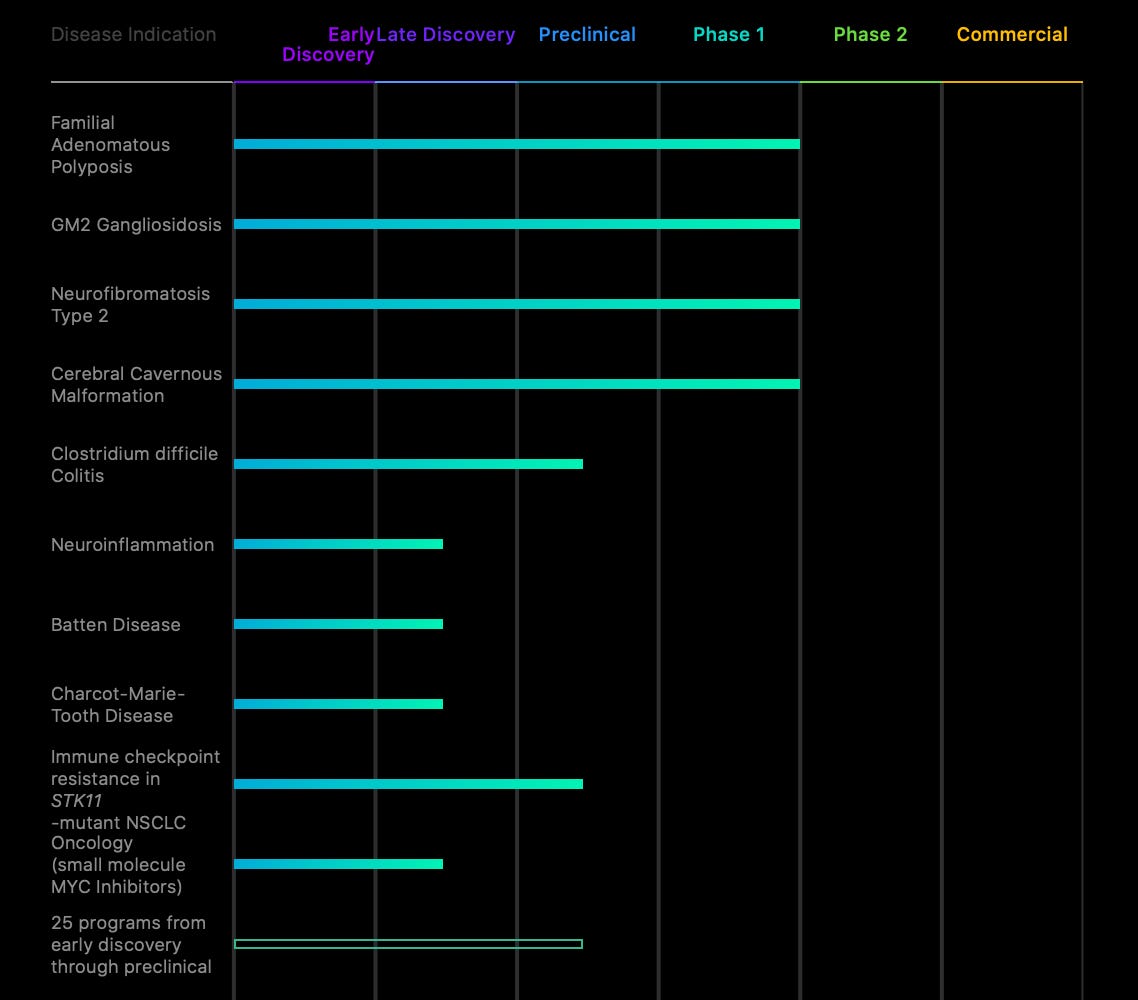Utah’s hottest biotech firm, Recursion Pharmaceuticals, is taking advantage of the red hot stock market as it has announced plans for a $100 million Initial Public Offering.
Over $1 billion and 12 years: and yet, on average, only 1 out of 5,000 cross the finish line.
That is the state of the costly, long, and arduous journey that awaits any entrepreneur that decides she or he is going to start a firm that plans to discover and develop new drugs.
To be clear, that’s not $1 billion in total capital such a company will need to fund its operations. That’s the average amount of money it takes to finance just one successful drug from inception to clearance by the U.S. Food & Drug Administration before it can start marketing/selling its new pill, potion, or concoction. Just one.
So even though Salt Lake City-based Recursion Pharmaceuticals announced last September that it had just closed on a $239 million Series D round of funding, I was not super shocked when Recursion announced early last week that it plans to “Go Public” in the weeks ahead with an Initial Public Offering.

According to Crunchbase, Recursion has raised over $465 million in venture capital (VC) and strategic partner funding since its founding in 2013.
But if it costs, on average, $1 billion to get a drug candidate through the long-and-winding road to final “approval,” why in the world would Recursion file for an IPO with plans to only raise $100 million? Doesn’t it need to raise a lot more money to be successful long-term?
Biopharma, Capital Needs, and Striking While the Iron Is Hot
First off, yes, Recursion is going to need A LOT MORE MONEY to be successful, long-term, as “The Digital Biology Company.”
As noted on the “Pipeline” page on its website, Recursion currently has
- Four compounds in Phase I Clinical Trials,
- Two compounds in Pre-Clinical Development, and
- An additional 29 diseases where it has identified (and is developing) targeted compounds to address these disease states, with said compounds in Early Discovery through Pre-Clinical Development.

As someone who has provided public relations, investor relations and marketing services to what became a very successful drug discovery/development company, trust me when I say,
“The fact that Recursion has 35 different drug candidates in its pipeline in roughly eight years, having raised under $500 million, is simply staggering.”
But even if Recursion is only successful in getting one drug candidate through the FDA clearance process over the next 5—10 years, the company will still likely spend upwards of $2 billion to $3 billion to work through that pipeline (including the costs associated with the majority of its candidates dropping out along the way).
So as several wise VC-funded executives have told me during my career,
“It’s better to raise money when you can raise it versus when you need it.”
According to its Consolidated Balance Sheets found in the Form S-1, Recursion filed with the SEC last week, the company had over $265 million in cash and cash equivalents on hand at the end of 2020, up from $75 million one year earlier. (See page F-3.)
That’s a fair amount of money in the bank, even for a firm with 35 drug candidates in its discovery and development pipeline and over 215 employees on its payroll.
But as its financials explain, Recursion is burning cash:
- Over $84 million in 2020 expenses,
- Up from $62 million in expenses in 2019.
This is not surprising. Nevertheless, I expect its expenses will continue to climb for the foreseeable future.
Interestingly, since the Great Recession of 2007—2010, the amount of potential investment dollars sitting on the sidelines has grown dramatically. How much so?
Some experts suggested in early 2019 that there was “$19.4 trillion in gross ‘cash’ and equivalents that ‘on the sidelines’ of the stock market.” And that was just in America.
And then the Covid-19 pandemic hit in March 2020.
Prior to the beginnings of the Covid-led shutdowns in the United States and around the globe, the Dow Jones Industrial Average (DJIA) hit 29,398 on February 10th. Just 36 days later, however, the DJIA had collapsed nearly 35% to 19,173 — clearly recession territory.
And yet a curious thing happened financially in 2020. By the end of the year, that five-week selloff on Wall Street had disappeared as the DJIA finished above 30,600 on December 28th.
And as of the market close yesterday, the DJIA finished at 33,171 — up 73% since the 2020 bottom on March 16th.
2020: The Best IPO Year Ever
I believe that one of the primary factors contributing to the rapid recovery of the DJIA (and Wall Street in general) was the fact that 2020 was the best year ever for Initial Public Offerings, with 420 IPOs completed, an all-time record.
Of these 2020 IPOs, leading Wall Street law firm Skadden Arps explained that a record number of 247 IPOs were accomplished through mergers into SPACs (Special Purpose Acquisition Companies) or “blank check” IPOs.
And this trend does not appear to be slowing down.
{Case in point, see the February 22, 2021 issue of Deseret Business Watch titled “Owlet SPAC, HealthEquity Money Raise, and More (The Week of Feb. 15-21 in Review).”}
Even crazier, however, is that there have already been nearly 400 IPOs in 2021.
Only one-third of these new listings are up from their opening Offering Prices, which is not cool from a shareholder standpoint. However, that is nearly 400 companies that were able to
- Raise money from external shareholders, and
- Can now provide their employees with an additional form of compensation that is also somewhat liquid in the form of publicly traded shares and stock options that can vest over time.
These, I believe, are the primary reasons it makes sense for Recursion to raise money now via an IPO.
And make no mistake about it, there is still a ton of money sitting on the sidelines waiting for the right opportunities to invest — like in the Recursion IPO.
What Sets Recursion Apart
Although there have been dramatic advancements in Artificial Intelligence, Machine Learning, and Big Data over the past decade, few pharmaceutical companies find themselves at the intersection of AI, ML and biology. And yet that is exactly where Recursion is today.
That’s why when you dig into the Recursion story, you find the company featured on the websites of technology publishers like ZDnet in stories titled “The subtle art of really big data: Recursion Pharma maps the body.”
This article (coupled with info found on the Recursion website, in its Form S-1, and elsewhere on the Web), weaves a fascinating story of the collision of biology and technology, with a goal of
“Decoding Biology to Radically Improve Lives.”
During its short history, Recursion has developed what it describes as the Recursion Operating System (Recursion OS) to allow it to achieve what it claims is a faster and faster flywheel effect for drug discovery and development.
What is the Recursion OS?
This is how the company describes its operating system in its Form S-1:
“The Recursion OS is an integrated, multi-layer system for generating, analyzing, and deriving insights from biological and chemical datasets. It consists of three parts:
“1. Infrastructure Layer: A synchronized network of highly scalable enabling hardware and software used to design and execute diverse biological experiments and subsequently store our ever-growing datasets. One of the cornerstones of this layer is our state-of-the-art ML supercomputer, BioHive-1, which we believe is one of the most powerful computers wholly owned by any single biopharmaceutical company for drug discovery applications and the 58th most advanced supercomputer overall.
“2. The Recursion Data Universe: As of March 22, 2021, our Recursion Data Universe contained nearly eight petabytes of highly relatable biological and chemical data spanning multiple different data modalities. The size of the Recursion Data Universe has grown more than threefold since 2018 and has continued to grow at an accelerating rate. For context, our dataset already requires more storage capacity than all of the feature-length films in human history in high-definition, combined.
“3. The Recursion Map: A suite of in-house software tools, algorithms, and machine learning approaches designed to process and translate data from the Recursion Data Universe into actionable insights for our research and development teams.”*
Simply put, Recursion is leveraging the latest advancements in technology in ways that few other firms on the planet are doing that are investigating new drug candidates.
A Few Closing Thoughts on the Recursion IPO
Until Recursion files one or more amended versions of its Form S-1, we will not know how many shares it actually intends to sell in its IPO or at what price range. So those critical details are still up in the air, probably for another couple of weeks.
My guess, however, is that the company will actually try to raise more than the $100 million stated in its initial S-1, perhaps north of $250 million.
Additionally, tucked away within the S-1 is this fact:
Recursion Pharmaceuticals paid nearly $1 million in 2020 to purchase the URL Recursion.com. Interesting, huh?
Anyway … congrats to CEO, Chris Gibson and the entire Recursion team for its forthcoming IPO.
Should be a fun ride!
* — NOTE: I made some formatting changes to this material quoted from the Recursion S-1 to improve readability within this issue of Deseret Business Watch.
NOTE: This article was originally published by Deseret Business Watch. A few minor editorial changes have been made with this version to better match the current Silicon Slopes writing style.



